Inventory and Spatiotemporal Patterns of Glacial Lakes in the HKH-TMHA Region from 1990 to 2020
Abstract
:1. Introduction
2. Study Area
3. Materials and Methods
3.1. Data Sources
3.1.1. Landsat Images
3.1.2. Digital Elevation Model (DEM)
3.1.3. Glacier Inventory Datasets
3.1.4. Meteorological Datasets
3.1.5. Other Datasets
3.2. Methods
3.2.1. Glacial Lake Identification Method
3.2.2. Accuracy Assessment
4. Results
4.1. Spatial Distribution of Glacial Lakes at Different Elevations
4.2. Spatial Distributions of Glacial Lakes in Various Size Classes
4.3. Spatial Distribution of Glacial Lakes with Different Terrain Aspects
4.4. Distribution of and Changes in Glacial Lakes in the HKH-TMHA Region between 1990 and 2020
4.5. Climate Change Driving Glacial Lake Changes
5. Discussion
5.1. Glacial Lake Changes and Glaciers
5.2. Glacial Lakes, Water Resources and Disasters
5.3. Comparisons with Recent Related Studies
5.4. Factors Influencing Lake Extraction in This Study
6. Conclusions
Author Contributions
Funding
Institutional Review Board Statement
Informed Consent Statement
Data Availability Statement
Acknowledgments
Conflicts of Interest
References
- Harrison, S.; Kargel, J.S.; Huggel, C.; Reynolds, J.; Shugar, D.H.; Betts, R.A.; Emmer, A.; Glasser, N.; Haritashya, U.K.; Klimeš, J.; et al. Climate change and the global pattern of moraine-dammed glacial lake outburst floods. Cryosphere 2018, 12, 1195–1209. [Google Scholar] [CrossRef] [Green Version]
- Yao, T. Glacial fluctuations and its impacts on lakes in the southern Tibetan Plateau. Chin. Sci. Bull. 2010, 55, 2071. [Google Scholar] [CrossRef] [Green Version]
- Dahe, Q.; Cunde, X.; Yongjian, D.; Tandong, Y.; Lingen, B.; Jiawen, R.E.N.; Ninglian, W.; Shiyin, L.; Lin, Z. Progress on cryospheric studies by international and Chinese communities and perspectives. J. Appl. Meteor. Sci. 2006, 17, 649–656. [Google Scholar]
- Wang, Z.T.; Su, H.C. Glaciers in the world and china: Distribution and their significance as water resources. J. Glaciol. Geocryol. 2003, 25, 498–503. [Google Scholar]
- Wang, W.; Xiang, Y.; Gao, Y.; Lu, A.; Yao, T. Rapid expansion of glacial lakes caused by climate and glacier retreat in the Central Himalayas. Hydrol. Proc. 2015, 29, 859–874. [Google Scholar] [CrossRef]
- Immerzeel, W.W.; Kraaijenbrink, P.D.; Shea, J.M.; Shrestha, A.B.; Pellicciotti, F.; Bierkens, M.F.; de Jong, S.M. High-resolution monitoring of Himalayan glacier dynamics using unmanned aerial vehicles. Remote Sens. Environ. 2014, 150, 93–103. [Google Scholar] [CrossRef]
- Gärtner-Roer, I.; Nussbaumer, S.U.; Hüsler, F.; Zemp, M. Worldwide Assessment of National Glacier Monitoring and Future Perspectives. Mt. Res. Dev. 2019, 39, 1–11. [Google Scholar] [CrossRef]
- Zemp, M. Glacier monitoring tracks progress in limiting climate change. Nature 2019, 576, 39. [Google Scholar] [CrossRef] [Green Version]
- Gardelle, J.; Arnaud, Y.; Berthier, E. Contrasted evolution of glacial lakes along the Hindu Kush Himalaya mountain range between 1990 and 2009. Glob. Planet. Chang. 2011, 75, 47–55. [Google Scholar] [CrossRef] [Green Version]
- WGMS. Fluctuations of Glaciers 2000–2005, Volume IX. ICSU (FAGS)/IUGG (IACS)/UNEP/UNESCO/WMO; World Glacier Monitoring Service: Zurich, Switzerland, 2008. [Google Scholar]
- Zemp, M.; Hoelzle, M.; Haeberli, W. Six decades of glacier mass-balance observations: A review of the worldwide monitoring network. Ann. Glaciol. 2009, 50, 101–111. [Google Scholar] [CrossRef] [Green Version]
- Kulkarni, A.V.; Rathore, B.P.; Alex, S. Monitoring of glacial mass balance in the Baspa basin using accumulation area ratio method. Curr. Sci. 2004, 86, 185–190. [Google Scholar]
- Lutz, A.F.; Immerzeel, W.W.; Shrestha, A.B.; Bierkens, M.F.P. Consistent increase in High Asia’s runoff due to increasing glacier melt and precipitation. Nat. Clim. Chang. 2014, 4, 587–592. [Google Scholar] [CrossRef] [Green Version]
- Zhang, Y.; Liu, S.Y.; Wang, X. A dataset of spatial distribution of degree-day factors for glaciers in High Mountain Asia. China Sci. Data 2019, 4, 141–151. [Google Scholar]
- Huggel, C.; Kääb, A.; Schneider, J.F. Climate and Geomorphic Risks in High-Mountain Environments: Glacier Hazards, Permafrost Hazards, and Glacier Lake Outburst Floods in Mountain Areas: Processes, Assessment, Prevention, Mitigation; Vienna, Austria, 10–13 November 2009. Eos 2010, 91, 103. [Google Scholar] [CrossRef] [Green Version]
- Wang, X.; Liu, S.; Ding, Y.; Guo, W.; Jiang, Z.; Lin, J.; Han, Y. An approach for estimating the breach probabilities of moraine-dammed lakes in the Chinese Himalayas using remote-sensing data. Nat. Hazards Earth Syst. Sci. 2012, 12, 3109–3122. [Google Scholar] [CrossRef] [Green Version]
- Rundquist, D.C.; Lawson, M.P.; Queen, L.P.; Cerveny, R.S. The relationship between summer-season rainfall events and lake-surface area1. Jawra J. Am. Water Resour. Assoc. 1987, 23, 493–508. [Google Scholar] [CrossRef]
- Racoviteanu, A.E.; Arnaud, Y.; Williams, M.W.; Ordoñez, J. Decadal changes in glacier parameters in the Cordillera Blanca, Peru, derived from remote sensing. J. Glaciol. 2008, 54, 499–510. [Google Scholar] [CrossRef] [Green Version]
- Watanabe, T.; Lamsal, D.; Ives, J.D. Evaluating the growth characteristics of a glacial lake and its degree of danger of outburst flooding: Imja Glacier, Khumbu Himal, Nepal. Nor. Geogr. Tidsskr. Nor. J. Geogr. 2009, 63, 255–267. [Google Scholar] [CrossRef]
- Allen, S.; Owens, I.; Sirguey, P. Satellite remote sensing procedures for glacial terrain analyses and hazard assessment in the Aoraki Mount Cook region, New Zealand. N. Z. J. Geol. Geophys. 2008, 51, 73–87. [Google Scholar] [CrossRef] [Green Version]
- Yang, C.D.; Wang, X.; Wei, J.F.; Liu, S.Y. A dataset of glacial lake inventory of West China in 2015. Chin. Sci. Data 2018, 3, 36–44. [Google Scholar]
- Doxaran, D.; Froidefond, J.-M.; Lavender, S.; Castaing, P. Spectral signature of highly turbid waters: Application with SPOT data to quantify suspended particulate matter concentrations. Remote Sens. Environ. 2002, 81, 149–161. [Google Scholar] [CrossRef]
- Frohn, R.C.; Henneth, K.M.; Eisner, W.R. Satellite remote sensing classification of thaw lakes and drained thaw lake basins on the North Slope of Alaska. Remote Sens. Environ. 2005, 97, 116–126. [Google Scholar] [CrossRef]
- McFeeters, S.K. The use of the Normalized Difference Water Index (NDWI) in the delineation of open water features. Int. J. Remote Sens. 1996, 17, 1425–1432. [Google Scholar] [CrossRef]
- Bhardwaj, A.; Singh, M.K.; Joshi, P.K.; Singh, S.; Sam, L.; Gupta, R.D.; Kumar, R. A lake detection algorithm (LDA) using Landsat 8 data: A comparative approach in glacial environment. Int. J. Appl. Earth Obs. Geoinf. 2015, 38, 150–163. [Google Scholar] [CrossRef]
- Frey, H.; Huggel, C.; Paul, F.; Haeberli, W. Automated detection of glacier lakes based on remote sensing in view of assessing associated hazard potentials. Grazer Schr. Der Geogr. Und Raumforsch. 2010, 45, 261–272. [Google Scholar]
- Mitkari, K.V.; Arora, M.K.; Tiwari, R.K. Extraction of Glacial Lakes in Gangotri Glacier Using Object-Based Image Analysis. IEEE J. Sel. Top. Appl. Earth Obs. Remote Sens. 2017, 10, 5275–5283. [Google Scholar] [CrossRef]
- Xu, H. Modification of normalised difference water index (NDWI) to enhance open water features in remotely sensed imagery. Int. J. Remote Sens. 2006, 27, 3025–3033. [Google Scholar] [CrossRef]
- Wangchuk, S.; Bolch, T. Mapping of glacial lakes using Sentinel-1 and Sentinel-2 data and a random forest classifier: Strengths and challenges. Sci. Remote Sens. 2020, 2, 100008. [Google Scholar] [CrossRef]
- Belgiu, M.; Drăguţ, L. Random forest in remote sensing: A review of applications and future directions. ISPRS J. Photogramm. Remote Sens. 2016, 114, 24–31. [Google Scholar] [CrossRef]
- Zhang, M.M.; Zhao, H.; Chen, F.; Zeng, J.Y. Evaluation of effective spectral features for glacial lake mapping by using Landsat-8 OLI imagery. J. Mt. Sci. 2020, 17, 2707–2723. [Google Scholar] [CrossRef]
- Bulley, H.N.N.; Bishop, M.P.; Shroder, J.F.; Haritashya, U.K. Integration of classification tree analyses and spatial metrics to assess changes in supraglacial lakes in the Karakoram Himalaya. Int. J. Remote Sens. 2012, 34, 387–411. [Google Scholar] [CrossRef]
- Li, J.L.; Sheng, Y.W.; Luo, J.C. Automatic extraction of himalayan glacial lakes with remote sensing. J. Remote Sens. 2011, 15, 29–43. [Google Scholar]
- Li, Y.C.; Zhang, J.; Liu, C.L. Extraction method of alpine small glacial lake in Qianhu Mountain area of Yunnan province based on Sentinel-2 image. Sci. Cartogr. Geogr. 2021, 46, 114–120. [Google Scholar]
- Rounce, D.R.; Watson, C.S.; McKinney, D.C. Identification of hazard and risk for glacial lakes in the Nepal Himalaya using satellite imagery from 2000–2015. Remote Sens. 2017, 9, 654. [Google Scholar] [CrossRef] [Green Version]
- Liu, X.C.; Xiao, C.D. Preliminary Study of the Jiemayangzong Glacier and Lake Variations in the Source Regions of the Yarlung Zangbo River in 1974–2010. J. Glaciol. Geocryol. 2011, 33, 488–496. [Google Scholar]
- Li, Z.G.; Yao, T.D.; Ye, Q.H.; Tian, L.D.; Li, C.C. Monitoring glacial variations based on remote sensing in the Luozha region, eastern Himalayas, 1980–2007. Geogr. Res. 2011, 26, 836–846. [Google Scholar]
- Wang, X.; Liu, S.Y.; Yao, X.J.; Guo, W.Q.; Yu, P.C.; Xu, J.L. Glacier Lake Investigation and Inventory in the Chinese Himalayas Based on the Remote Sensing Data. Acta Geogr. Sin. 2010, 65, 29–36. [Google Scholar]
- Pan, M.; Cao, Y.G. Present status and perspectives of remote sensing survey of glacial lakes in High Asia. Remote Sens. Land Resour. 2021, 33, 1–8. [Google Scholar]
- Nie, Y.; Sheng, Y.; Liu, Q.; Liu, L.; Liu, S.; Zhang, Y.; Song, C. A regional-scale assessment of Himalayan glacial lake changes using satellite observations from 1990 to 2015. Remote Sens. Environ. 2017, 189, 1–13. [Google Scholar] [CrossRef] [Green Version]
- Li, D.; Shangguan, D.; Anjum, M.N. Glacial Lake Inventory Derived from Landsat 8 OLI in 2016–2018 in China–Pakistan Economic Corridor. ISPRS Int. J. Geo-Inf. 2020, 9, 294. [Google Scholar] [CrossRef]
- Zhang, M.; Chen, F.; Zhao, H.; Wang, J.; Wang, N. Recent Changes of Glacial Lakes in the High Mountain Asia and Its Potential Controlling Factors Analysis. Remote Sens. 2021, 13, 3757. [Google Scholar] [CrossRef]
- Zhang, G.; Yao, T.; Xie, H.; Wang, W.; Yang, W. An inventory of glacial lakes in the Third Pole region and their changes in response to global warming. Glob. Planet. Chang. 2015, 131, 148–157. [Google Scholar] [CrossRef]
- Chen, F.; Zhang, M.M.; Guo, H.D.; Allen, S.; Kargel, J.S.; Haritashya, U.K.; Watson, C.S. Annual 30 m dataset for glacial lakes in High Mountain Asia from 2008 to 2017. Earth Syst. Sci. Data 2021, 13, 741–766. [Google Scholar] [CrossRef]
- Maharjan, S.B.; Mool, P.K.; Lizong, W.; Xiao, G.; Shrestha, F.; Shrestha, R.B.; Khanal, N.R.; Bajracharya, S.R.; Shai, S.; Baral, P. The Status of Glacial Lakes in the Hindu Kush Himalaya—ICIMOD Research Report 2018/1; International Centre for Integrated Mountain Development (ICIMOD): Kathmandu, Nepal, 2018. [Google Scholar]
- Wang, X.; Guo, X.Y.; Yang, C.D.; Liu, Q.H.; Wei, J.F.; Zhang, Y.; Liu, S.Y.; Zhang, Y.L.; Jiang, Z.L.; Tang, Z.G. Glacial lake inventory of high-mountain Asia in 1990 and 2018 derived from Landsat images. Earth Syst. Sci. Data 2020, 12, 2169–2182. [Google Scholar] [CrossRef]
- Zheng, G.X.; Allen, S.K.; Bao, A.M.; Ballesteros-Cánovas, J.A.; Huss, M.; Zhang, G.Q.; Li, J.L.; Yuan, Y.; Jiang, L.L.; Yu, T.; et al. Increasing risk of glacial lake outburst floods from future Third Pole deglaciation. Nat. Clim. Chang. 2021, 11, 411–417. [Google Scholar] [CrossRef]
- Immerzeel, W.W.; Bierkens, M.F.P. Seasonal prediction of monsoon rainfall in three Asian river basins: The importance of snow cover on the Tibetan Plateau. Int. J. Clim. 2009, 30, 1835–1842. [Google Scholar] [CrossRef]
- Ran, Y.H.; Li, X.; Cheng, G.D.; Zhang, T.J.; Wu, Q.B.; Jin, H.J.; Jin, R. Short Communication Distribution of Permafrost in China: An Overview of Existing Permafrost Maps. Permafr. Periglac. Proc. 2012, 23, 322–333. [Google Scholar] [CrossRef]
- Qin, D.H. Map of Glacier Resources in the Himalayas; Science Press: Beijing, China, 1999. [Google Scholar]
- Liu, S.Y.; Yao, X.J.; Guo, W.Q.; Xu, J.L.; Shangguan, D.H.; Wei, J.F.; Bao, W.J.; Wu, L.Z. The contemporary glaciers in China based on the Second Chinese Glacier Inventory. Acta Geogr. Sin. 2015, 70, 3–16. [Google Scholar]
- Sexton, J.O.; Song, X.-P.; Huang, C.; Channan, S.; Baker, M.E.; Townshend, J.R. Urban growth of the Washington, D.C.–Baltimore, MD metropolitan region from 1984 to 2010 by annual, Landsat-based estimates of impervious cover. Remote Sens. Environ. 2013, 129, 42–53. [Google Scholar] [CrossRef]
- Song, X.P.; Sexton, J.O.; Huang, C.Q.; Channan, S.; Townshend, J.R. Characterizing the magnitude, timing and duration of urban growth from time series of Landsat-based estimates of impervious cover. Remote Sens. Environ. 2016, 175, 1–13. [Google Scholar] [CrossRef]
- Xue, X.J.; Liu, H.P.; Mu, X.D.; Liu, J.X. Trajectory-based detection of urban expansion using Landsat time series. Int. J. Remote Sens. 2014, 35, 1450–1465. [Google Scholar] [CrossRef]
- Arendt, A.; Bliss, A.; Bolch, T.; Cogley, J.; Gardner, A.; Hagen, J.-O.; Hock, R.; Huss, M.; Kaser, G.; Kienholz, C. Ran-Dolph Glacier Inventory-A Dataset of Global Glacier Outlines: Version6.0: Technical Report, Global Land Ice Measure-Ments from Space; RGI Consortium: Boulder, CO, USA, 2017. [Google Scholar]
- Liu, S.Y.; Guo, W.Q.; Xu, J.L. The Second Glacial Catalogue Data Set of China (v1.0); National Cryosphere Desert Data Center: Lanzhou, China, 2019. [Google Scholar]
- Fan, Y.; van den Dool, H. A global monthly land surface air temperature analysis for 1948–present. J. Geophys. Res. Atmos. 2008, 113, 01103. [Google Scholar] [CrossRef]
- Xie, P.P.; Yatagai, A.; Chen, M.Y.; Hayasaka, T.; Fukushima, Y.; Liu, C.M.; Yang, S. A Gauge-Based Analysis of Daily Precipitation over East Asia. J. Hydrometeorol. 2007, 8, 607–626. [Google Scholar] [CrossRef]
- Chen, M.Y.; Shi, W.; Xie, P.P.; Silva, V.B.S.; Kousky, V.E.; Higgins, R.W.; Janowiak, J.E. Assessing objective techniques for gauge-based analyses of global daily precipitation. J. Geophys. Res. Earth Surf. 2008, 113, 04110. [Google Scholar] [CrossRef]
- Chen, M.Y.; Xie, P.P. CPC unified gauge-based analysis of global daily precipitation. In Proceedings of the Western Pacific Ge-ophysics Meeting, Cairns, Australia, 29 July–1 August 2008. [Google Scholar]
- Wang, X.Y.; Wang, J.; Jiang, Z.Y.; Li, H.Y.; Hao, X.H. An Effective Method for Snow-Cover Mapping of Dense Conif-erous Forests in the Upper Heihe River Basin Using Landsat Operational Land Imager Data. Remote Sens. 2015, 7, 17246–17257. [Google Scholar] [CrossRef] [Green Version]
- Li, W.P.; Wang, W.; Gao, X.; Wu, Y.M.; Wang, X.C.; Liu, Q. A lake extraction method in mountainous regions based on the integration of object-oriented approach and watershed algorithm. J. Geo-Inf. 2021, 23, 1272–1285. [Google Scholar]
- Mool, P.; Wangda, D.; Bajracharya, S.R. Inventory of Glaciers, Glacial Lakes and Glacial Lake Outburst Floods: Monitoring and Early Warning Systems in the Hindu Kush-Himalayan Region, Bhutan; ICIMOD: Kathmandu, Nepal, 2001. [Google Scholar]
- Qin, D.H. Glossary of Cryosphere Science; China Meteorological Press: Beijing, China, 2014. [Google Scholar]
- Yao, X.J.; Liu, S.Y.; Han, L.; Sun, M.P.; Zhao, L.L. Definition and classification system of glacial lake for inventory and hazards study. J. Geogr. Sci. 2018, 28, 193–205. [Google Scholar] [CrossRef] [Green Version]
- Hall, D.K.; Bayr, K.J.; Schoner, W.; Bindschadler, R.A.; Chien, J.Y.L. Consideration of the errors inherent in mapping historical glacier positions in Austria from the ground and space (1893–2001). Remote Sens. Environ. 2003, 86, 566–577. [Google Scholar] [CrossRef]
- Salerno, F.; Thakuri, S.; D’Agata, C.; Smiraglia, C.; Manfredi, E.C.; Viviano, G.; Tartari, G. Glacial lake distribution in the Mount Everest region: Uncertainty of measurement and conditions of formation. Glob. Planet. Chang. 2012, 92–93, 30–39. [Google Scholar] [CrossRef]
- Hanshaw, M.N.; Bookhagen, B. Glacial areas, lake areas, and snow lines from 1975 to 2012: Status of the Cordillera Vilcanota, including the Quelccaya Ice Cap, northern central Andes, Peru. Cryosphere 2014, 8, 359–376. [Google Scholar] [CrossRef] [Green Version]
- Frey, H.; Haeberli, W.; Linsbauer, A.; Huggel, C.; Paul, F. A multi-level strategy for anticipating future glacier lake for-mation and associated hazard potentials. Nat. Hazards Earth Syst. Sci. 2010, 10, 339–352. [Google Scholar] [CrossRef] [Green Version]
- Wang, X.; Siegert, F.; Zhou, A.G.; Franke, J. Glacier and glacial lake changes and their relationship in the context of climate change, Central Tibetan Plateau 1972–2010. Glob. Planet. Chang. 2013, 111, 246–257. [Google Scholar] [CrossRef]
- Yang, K.; Lu, H.; Yue, S.Y.; Zhang, G.Q.; Lei, Y.B.; La, Z.; Wang, W. Quantifying recent precipitation change and pre-dicting lake expansion in the Inner Tibetan Plateau. Clim. Chang. 2018, 147, 149–163. [Google Scholar] [CrossRef]
- Zhu, L.P.; Lu, X.M.; Wang, J.B.; Peng, P.; Kasper, T.; Daut, G.; Haberzettl, T.; Frenzel, P.; Li, Q.; Yang, R.M.; et al. Climate change on the Tibetan Plateau in response to shifting atmospheric circulation since the LGM. Sci. Rep. 2015, 5, 13318. [Google Scholar] [CrossRef] [PubMed]
- Wu, B.Y. Weakening of Indian Summer Monsoon in Recent Decades. Adv. Atmos. Sci. 2005, 22, 21–29. [Google Scholar]
- Bolch, T.; Kulkarni, A.; Kaab, A.; Huggel, C.; Paul, F.; Cogley, G.; Frey, H.; Kargel, J.S.; Fujita, K.; Scheel, M.; et al. The State and Fate of Himalayan Glaciers. Science 2012, 336, 310–314. [Google Scholar] [CrossRef] [Green Version]
- Luo, W.; Zhang, G.Q.; Chen, W.F.; Xu, F.L. Response of glacial lakes to glacier and climate changes in the western Nyainqentanglha range. Sci. Total Environ. 2020, 735, 139607. [Google Scholar] [CrossRef]
- Liu, J.J.; Cheng, Z.L.; Su, P.C. The relationship between air temperature fluctuation and Glacial Lake Outburst Floods in Tibet, China. Quat. Int. 2014, 321, 78–87. [Google Scholar] [CrossRef]
- Guo, C.K. The Change of Glacial Lakes and Its Influence in Everest Region. Master’s Thesis, Hunan University of Science and Technology, Xiangtan, China, 2017. [Google Scholar]
- Cogley, G.J. Glacier shrinkage across High Mountain Asia. Ann. Glaciol. 2016, 57, 41–49. [Google Scholar] [CrossRef] [Green Version]
- Yao, T.D.; Thompson, L.; Yang, W.; Yu, W.S.; Gao, Y.; Guo, X.J.; Yang, X.X.; Duan, K.Q.; Zhao, H.B.; Xu, B.Q.; et al. Different glacier status with atmospheric circulations in Tibetan Plateau and surroundings. Nat. Clim. Chang. 2012, 2, 663–667. [Google Scholar] [CrossRef]
- Zhang, G.Q.; Bolch, T.; Allen, S.; Linsbauer, A.; Chen, W.F.; Wang, W.C. Glacial lake evolution and glacier-lake inter-actions in the Poiqu River basin, central Himalaya, 1964–2017. J. Glaciol. 2019, 65, 347–365. [Google Scholar] [CrossRef] [Green Version]
- Thompson, S.S.; Benn, D.I.; Dennis, K.; Luckman, A. A rapidly growing moraine-dammed glacial lake on Ngozumpa Glacier, Nepal. Geomorphology 2012, 145–146, 1–11. [Google Scholar] [CrossRef]
- Wang, X.; Ding, Y.J.; Liu, S.Y.; Jiang, L.H.; Wu, K.P.; Jiang, Z.L.; Guo, W.Q. Changes of glacial lakes and implications in Tian Shan, central Asia, based on remote sensing data from 1990 to 2010. Environ. Res. Lett. 2013, 8, 044052. [Google Scholar] [CrossRef]
- Wang, X.; Ding, Y.J.; Zhang, Y. The influence of glacier meltwater on the hydrological effect of glacial lakes in Mountain Cryosphere. J. Lake Sci. 2019, 31, 609–620. [Google Scholar]
- Liu, J.K.; Zhang, J.J.; Gao, B.; Li, Y.L.; Li, M.Y.; WuJin, D.J.; Zhou, L.X. An overview of glacial lake outburst flood in Tibet, China. J. Glaciol. Geocryol. 2019, 41, 1335–1347. [Google Scholar]
- Lv, R.R. Debris Flow and Environment in Tibet; University of Science and Technology Press: Chengdu, China, 1999; pp. 69–109. [Google Scholar]
- Zhang, T.G.; Wang, W.C.; Gao, T.G.; An, B.S.; Shang, X.X. Glacial lake outburst floods on the High Mountain Asia: A review. J Glaciol. Geocryol. 2022, 43, 1673–1692. [Google Scholar]
- Prakash, C.; Nagarajan, R. Glacial lake changes and outburst flood hazard in Chandra basin, North-Western Indian Himalaya. Geomat. Nat. Hazards Risk 2018, 9, 337–355. [Google Scholar] [CrossRef] [Green Version]
- Hanshaw, M.N.; Bookhagen, B. Glacial areas, lake areas, and snowlines from 1975 to 2012: Status of the Cordillera Vilcanota, including the Quelccaya Ice Cap, northern central Andes, Peru. Cryosphere Discuss. 2013, 7, 573–634. [Google Scholar]
- Ma, J.S.; Song, C.Q.; Wang, Y.J. Spatially and Temporally Resolved Monitoring of Glacial Lake Changes in Alps During the Recent Two Decades. Front. Earth Sci. 2021, 9, 723386. [Google Scholar] [CrossRef]
- Casu, F.; Manzo, M.; Lanari, R. A quantitative assessment of the SBAS algorithm performance for surface deformation retrieval from DInSAR data. Remote Sens. Environ. 2006, 102, 195–210. [Google Scholar] [CrossRef]
- Mora, O.; Mallorqui, J.J.; Broquetas, A. Linear and nonlinear terrain deformation maps from a reduced set of interferometric sar images. IEEE Trans. Geosci. Remote Sens. 2003, 41, 2243–2253. [Google Scholar] [CrossRef]
- Yu, X.Y. Improved SBAS Technology for Land Deformation Detection and Groundwater Application. Ph.D. Thesis, Central South University, Changsha, China, 2012. [Google Scholar]
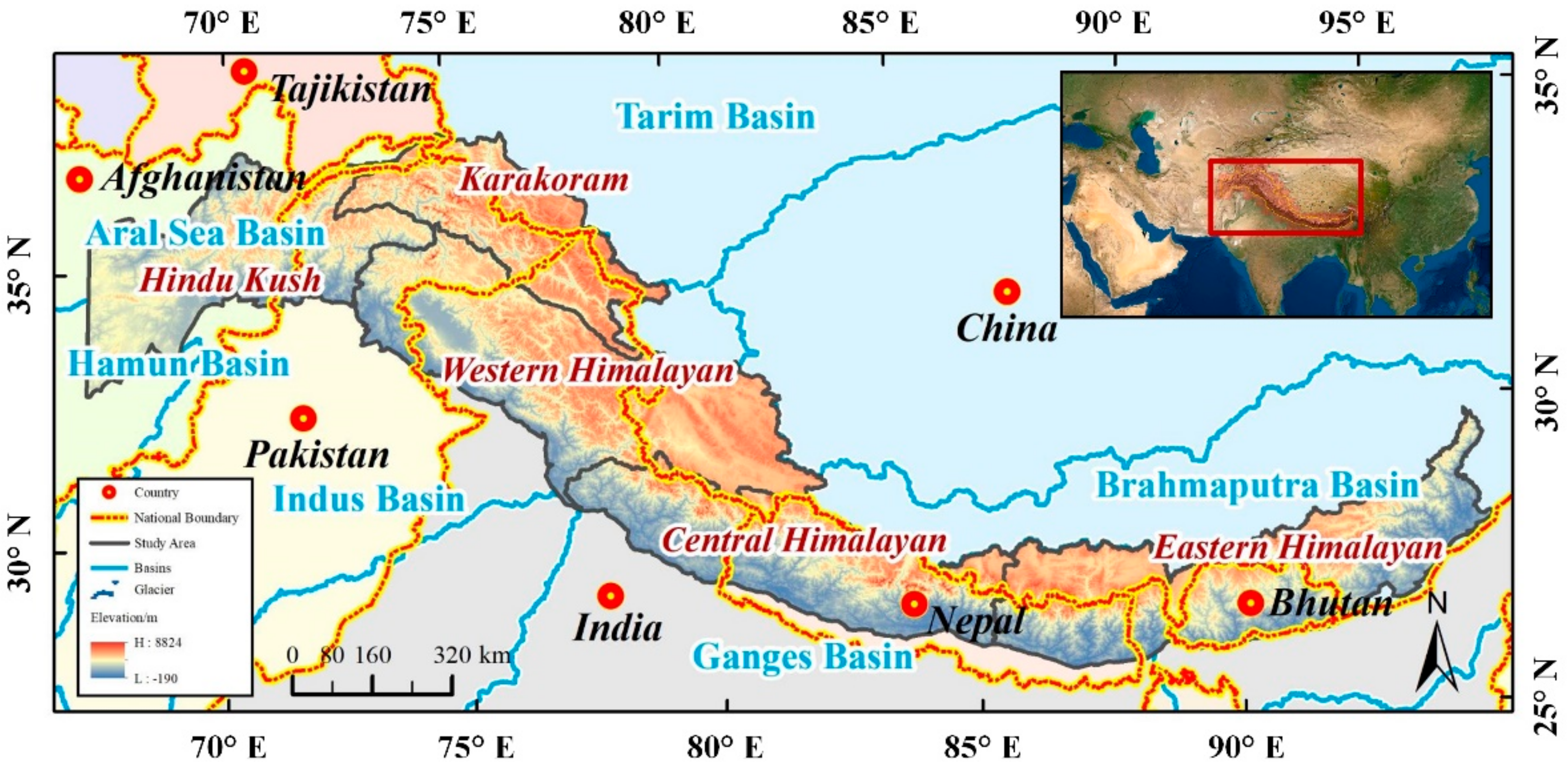
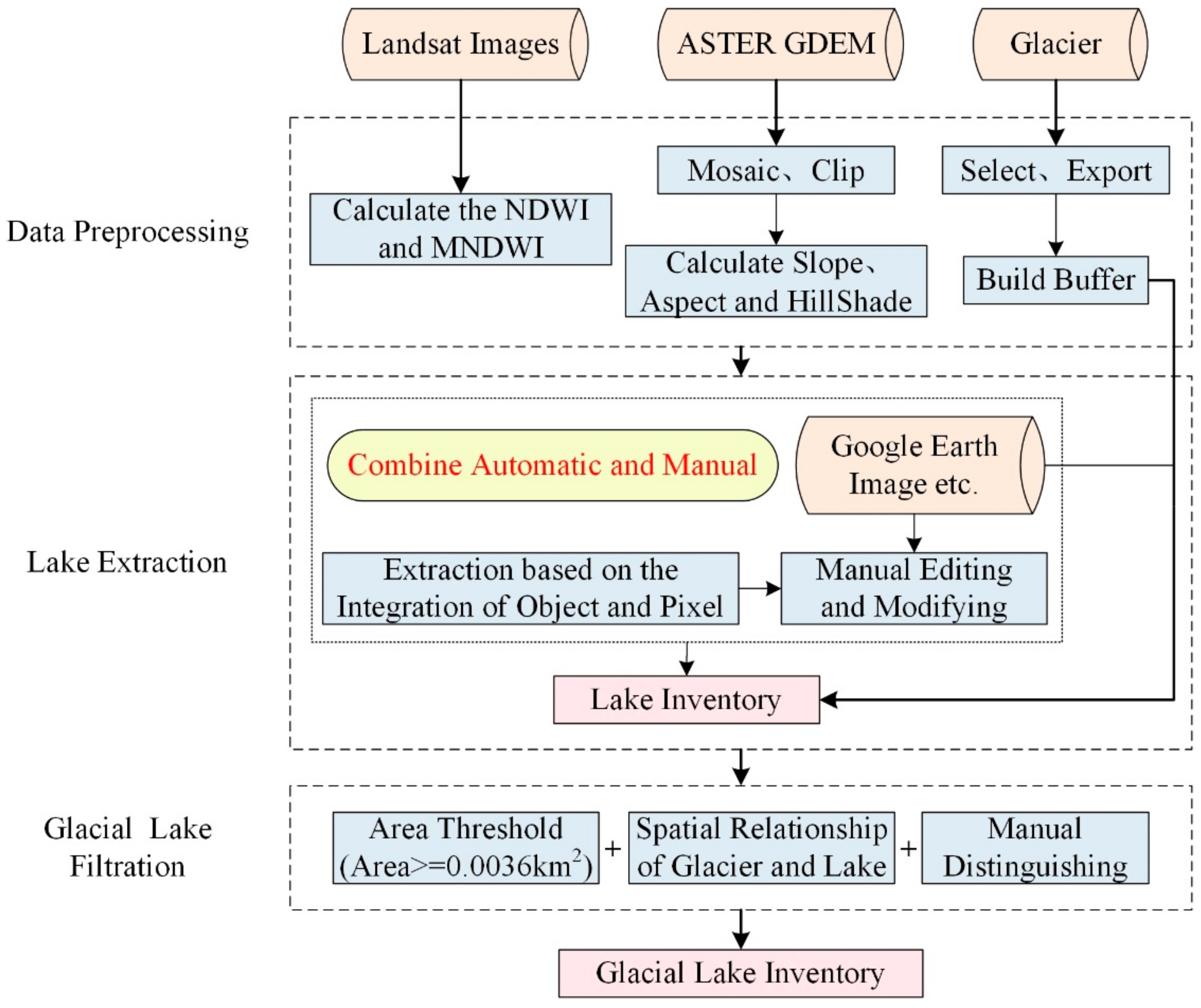
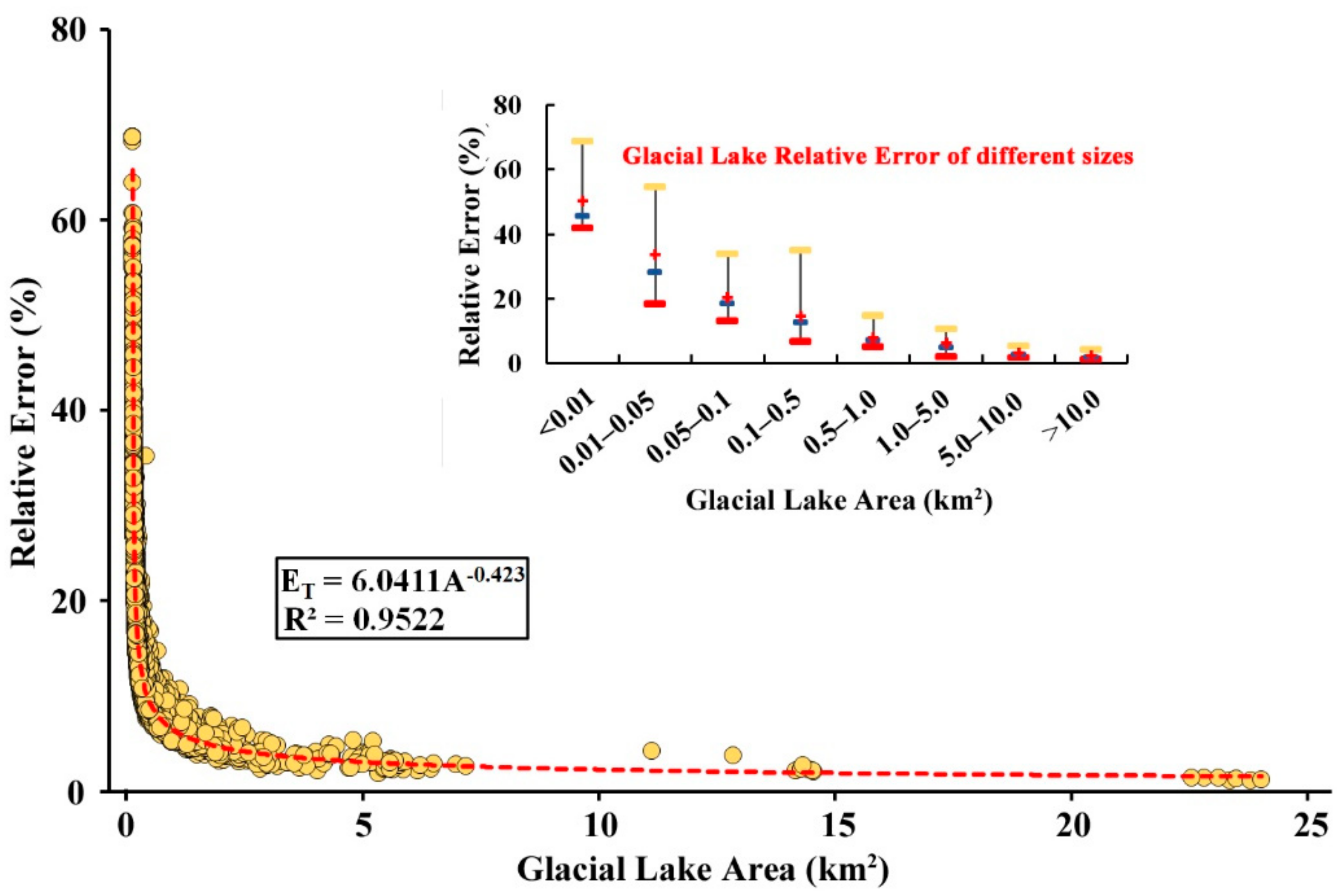
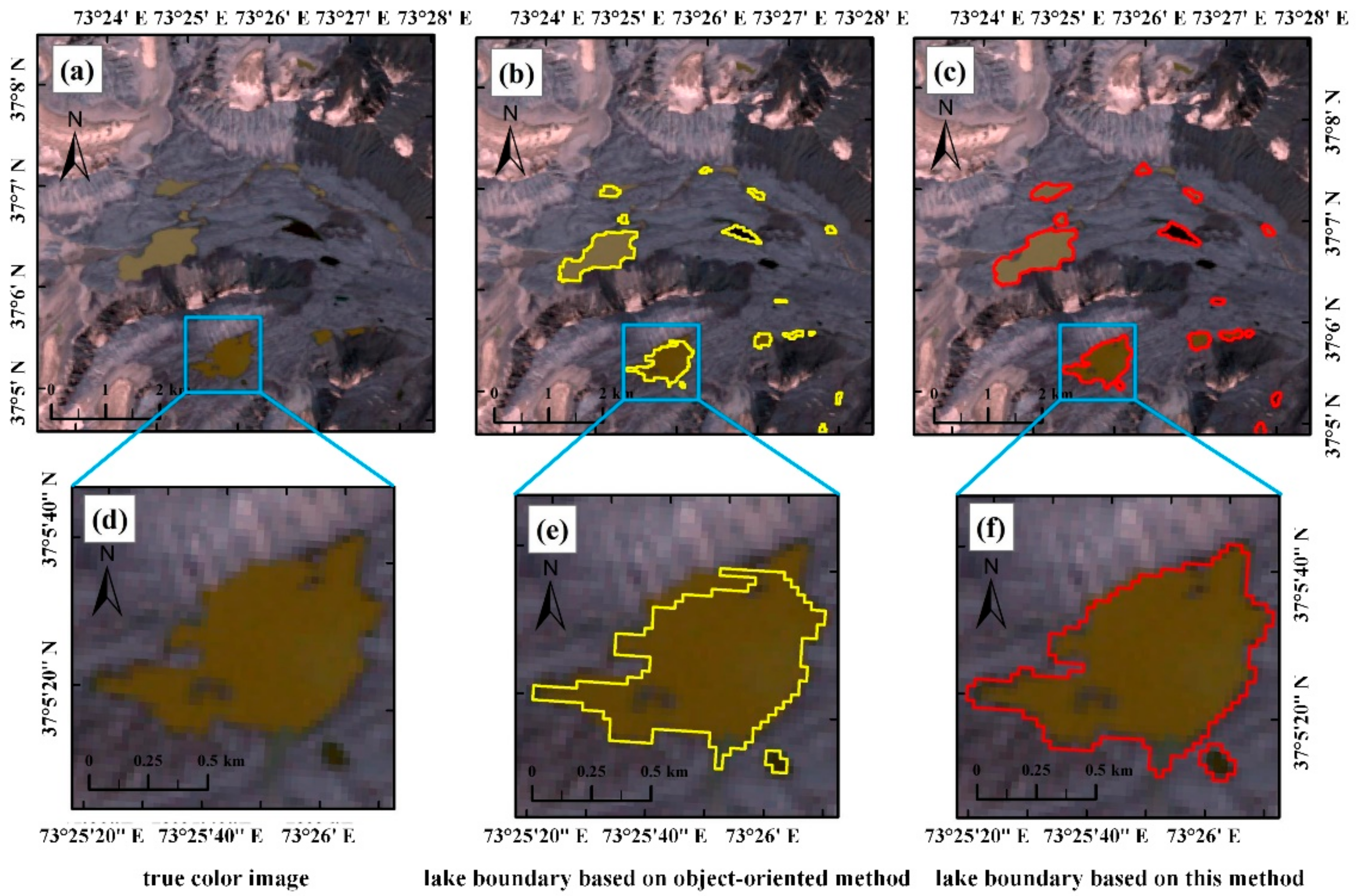

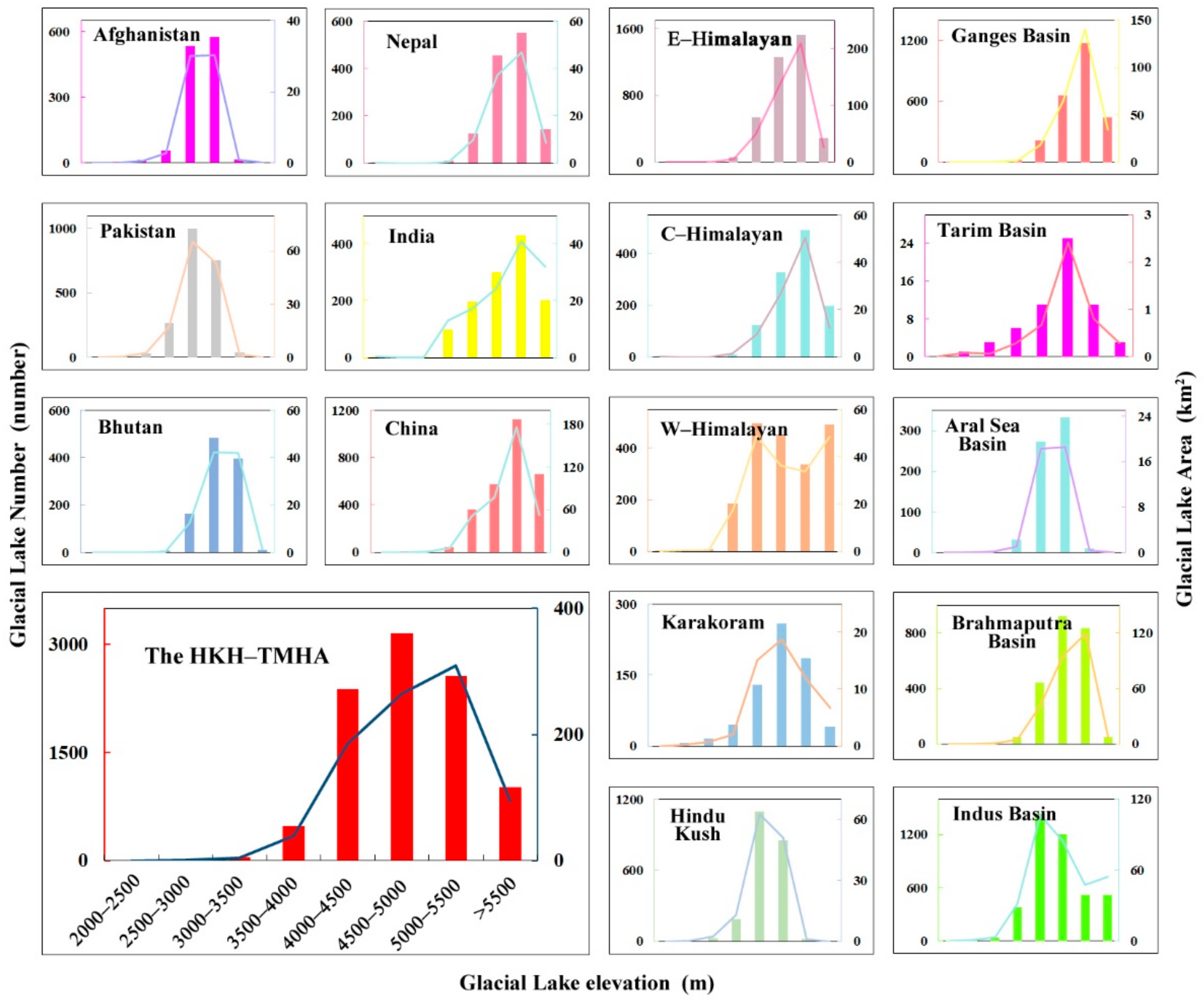
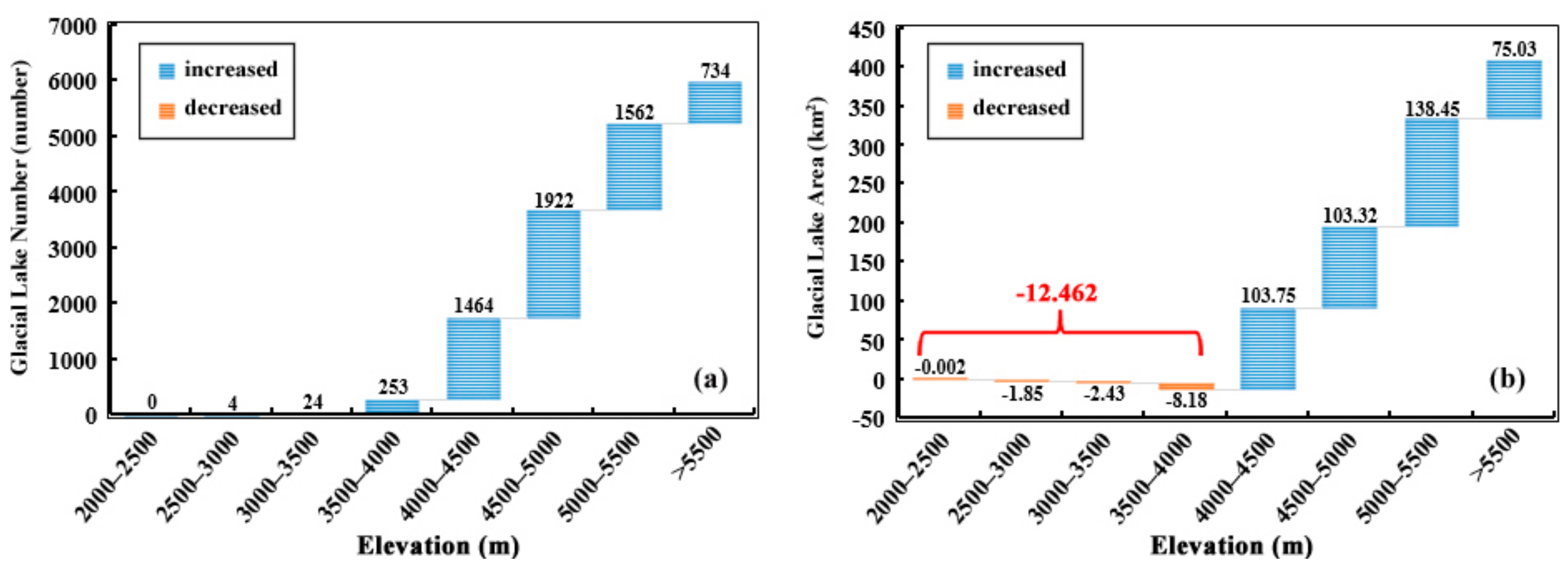
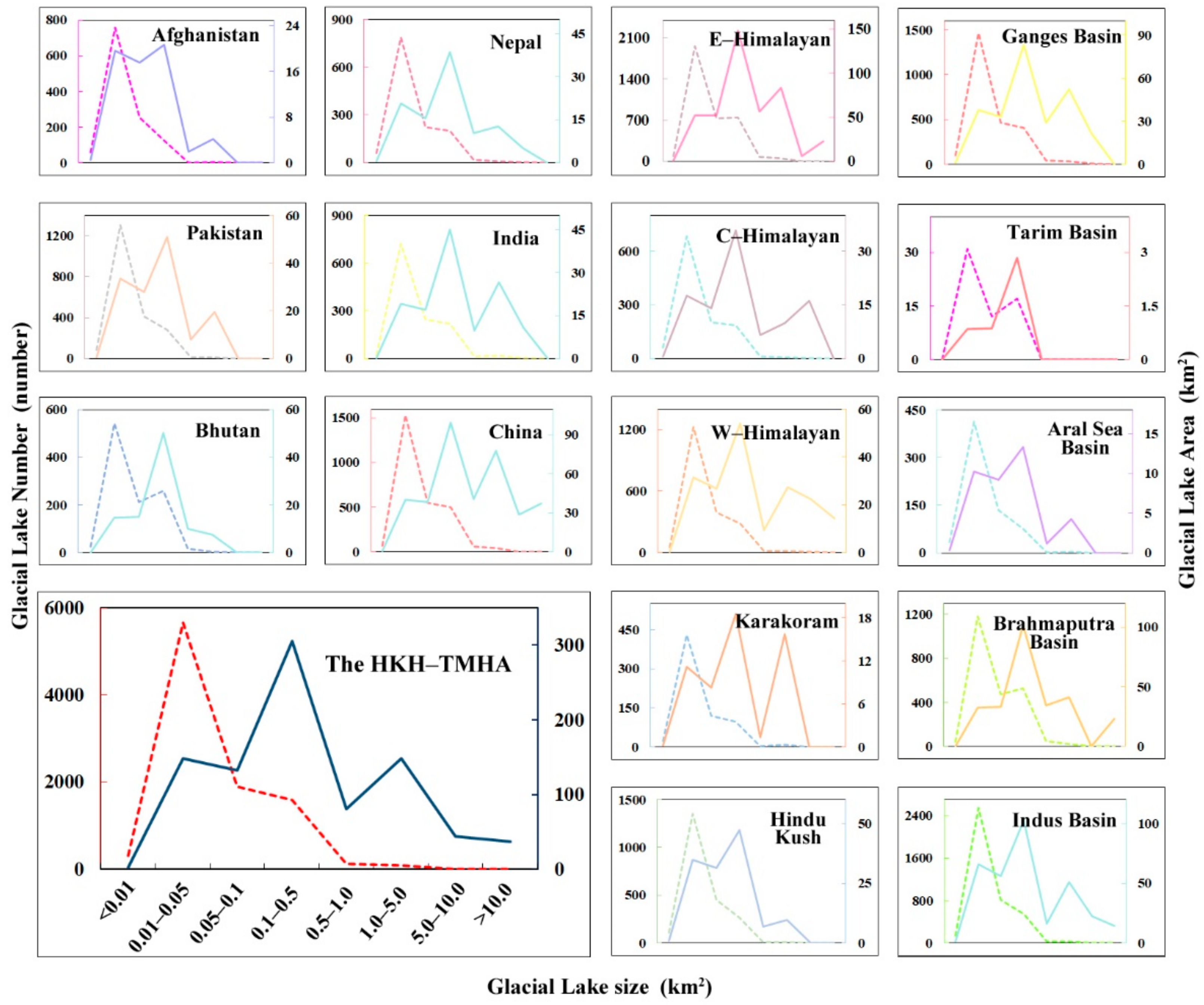
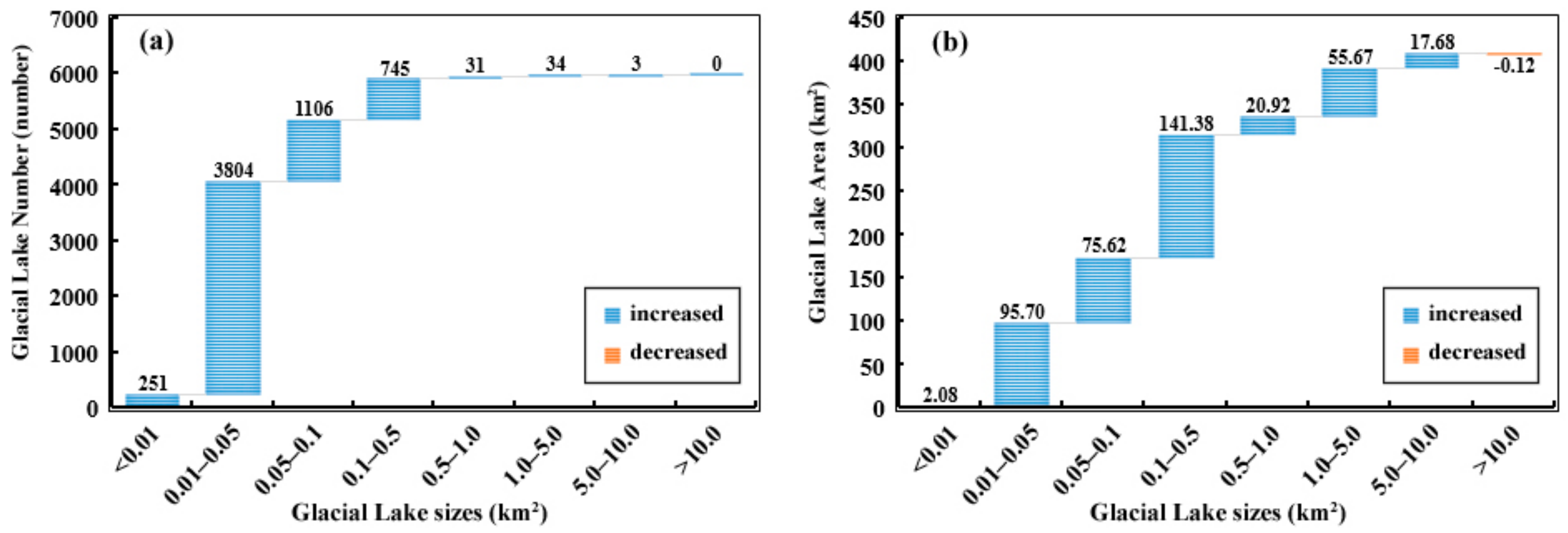

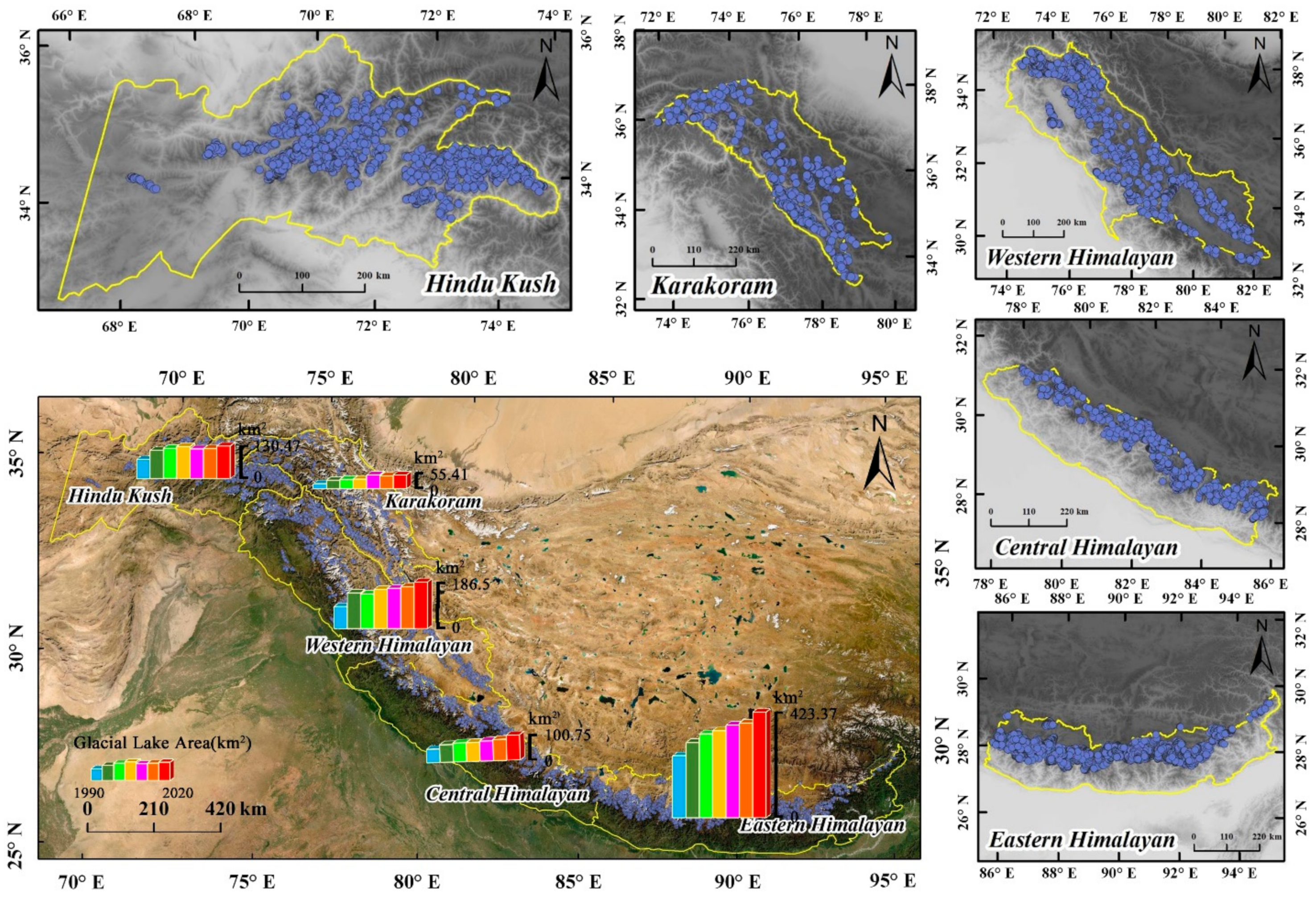
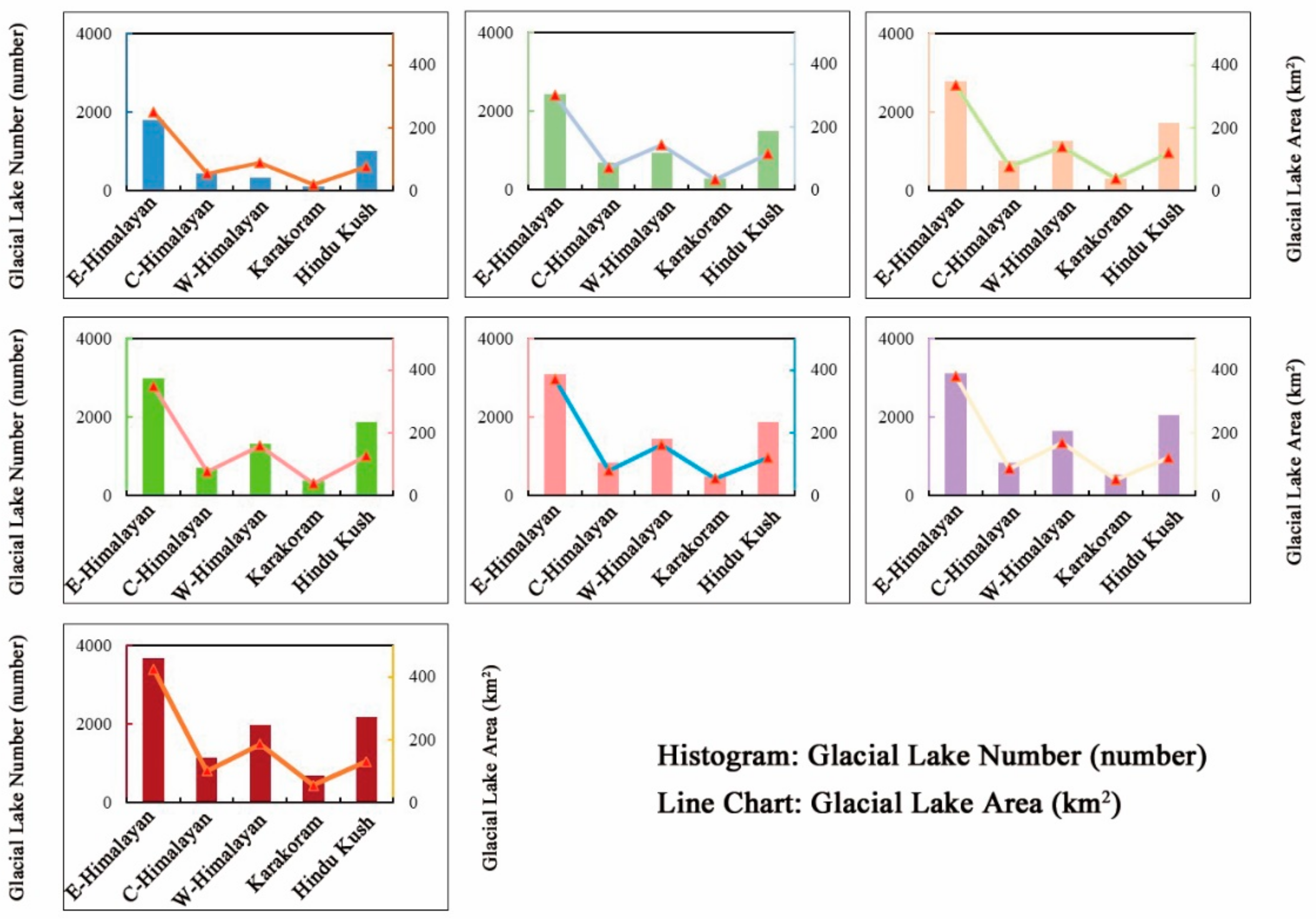

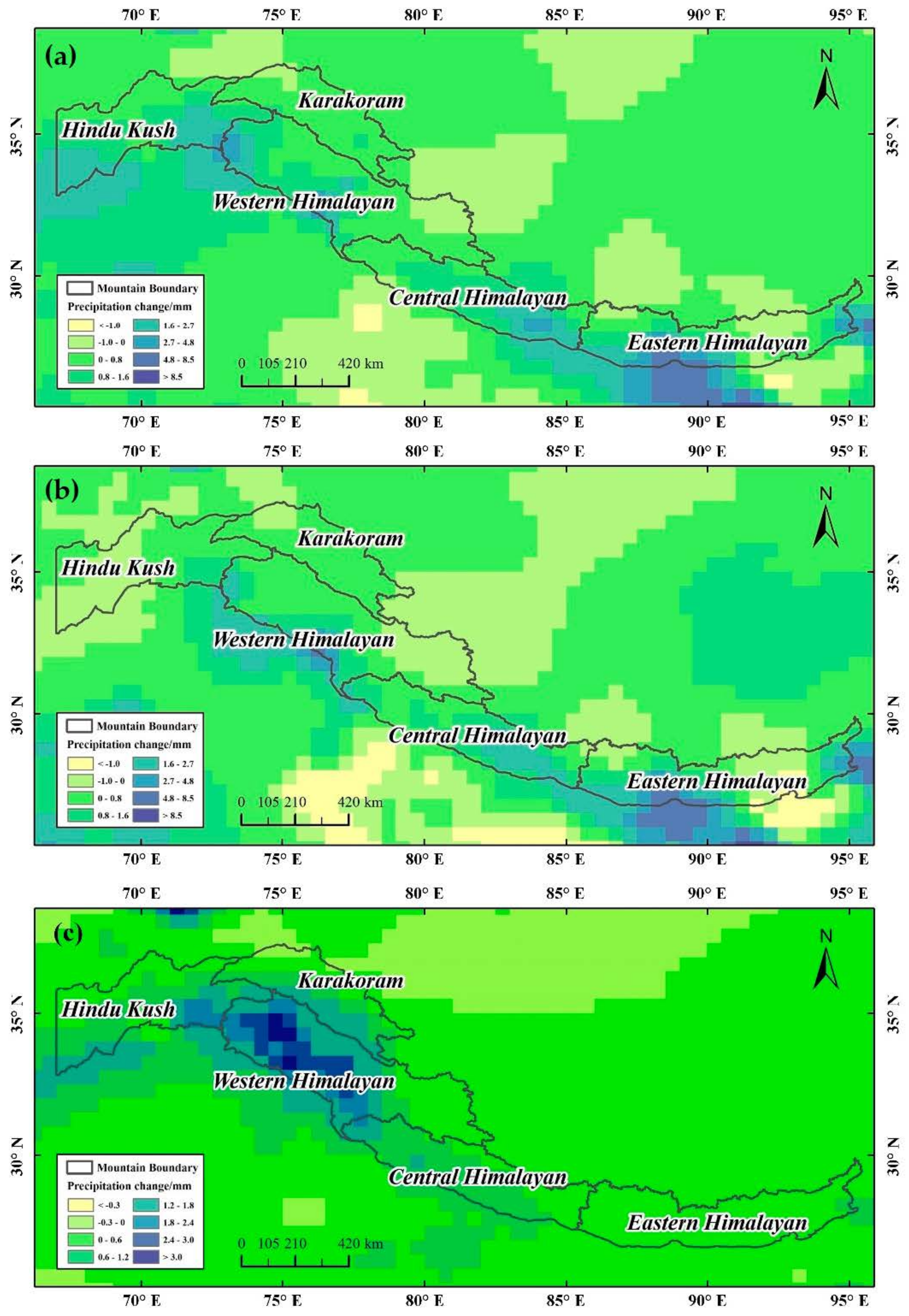
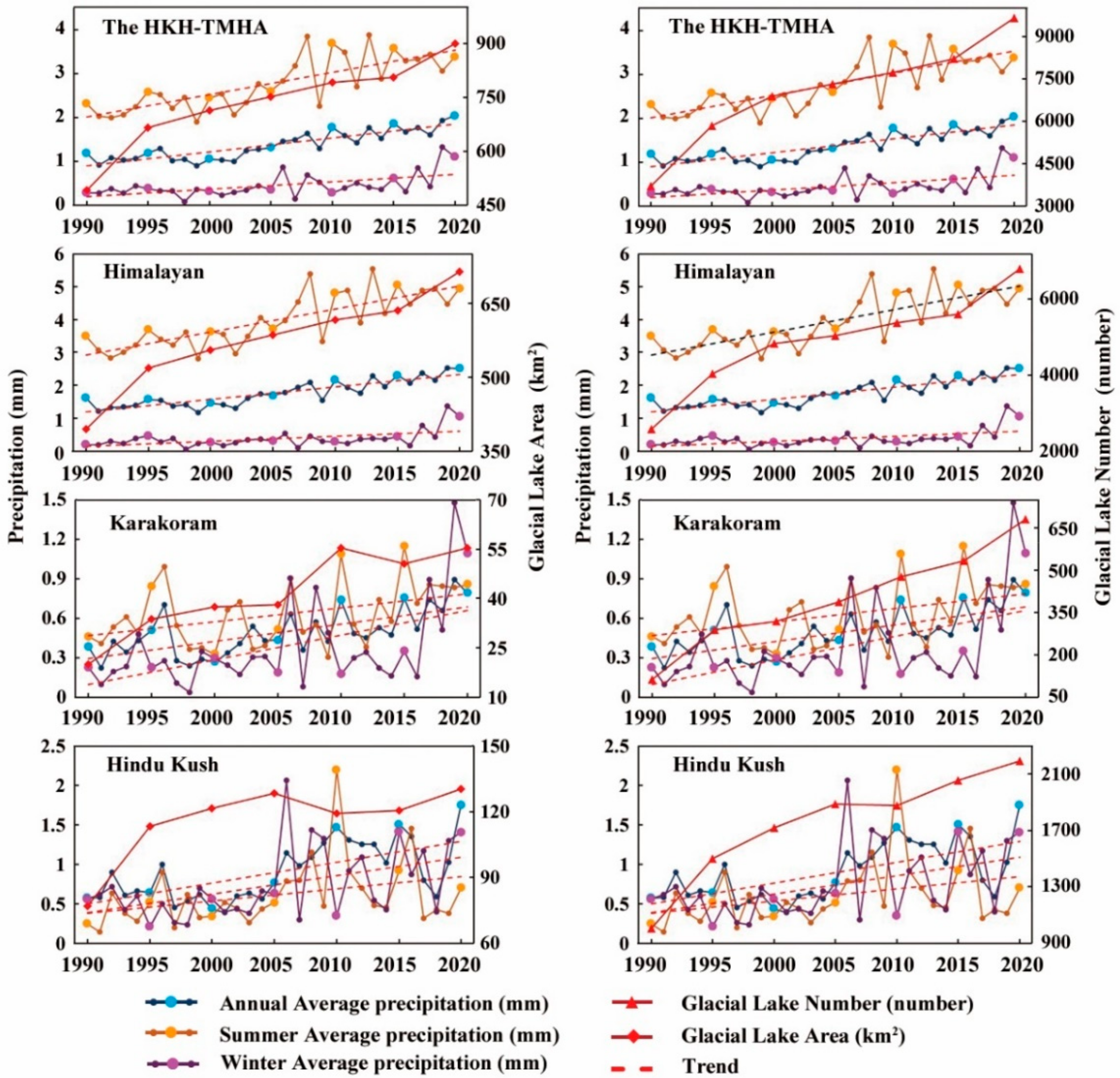
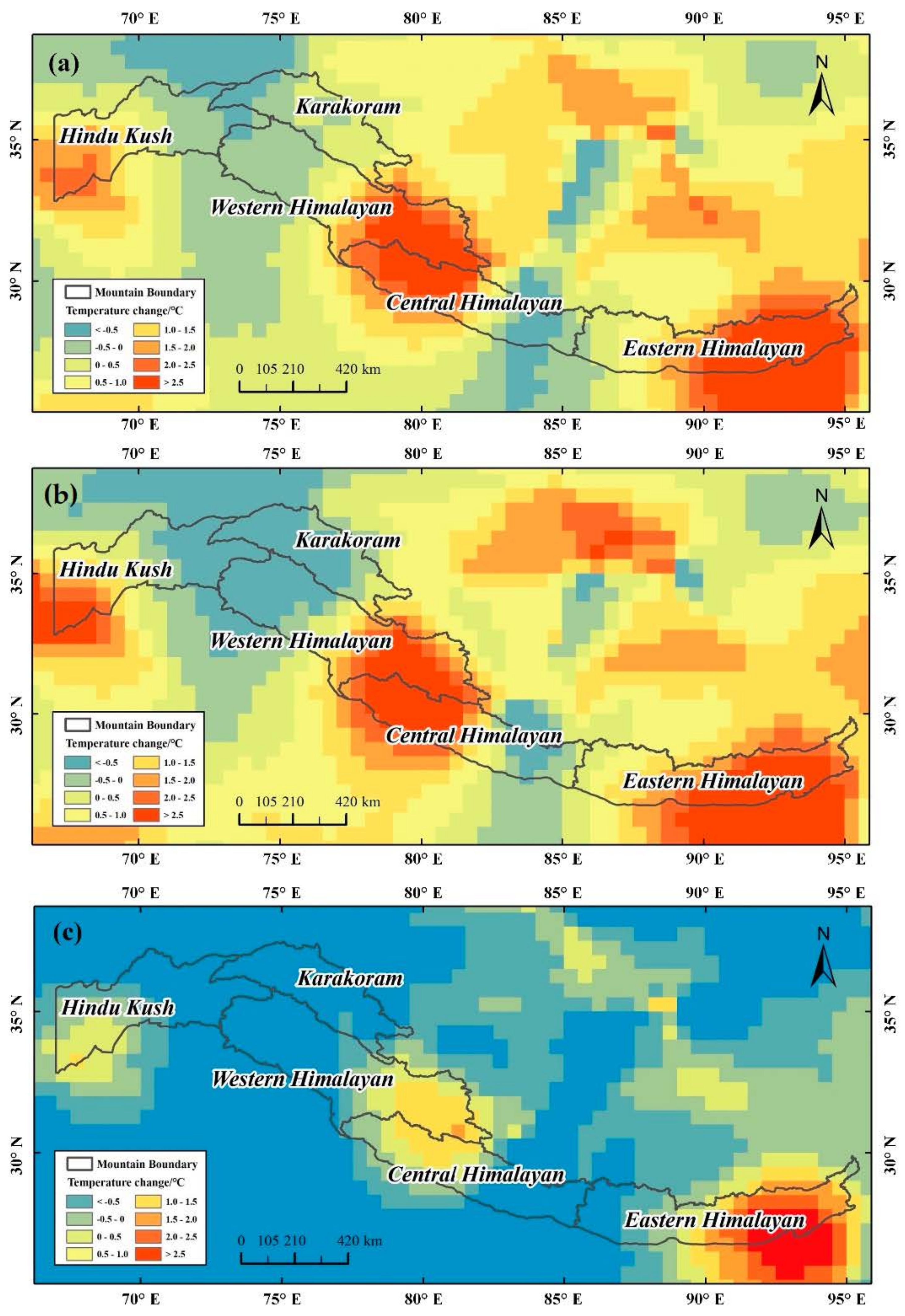
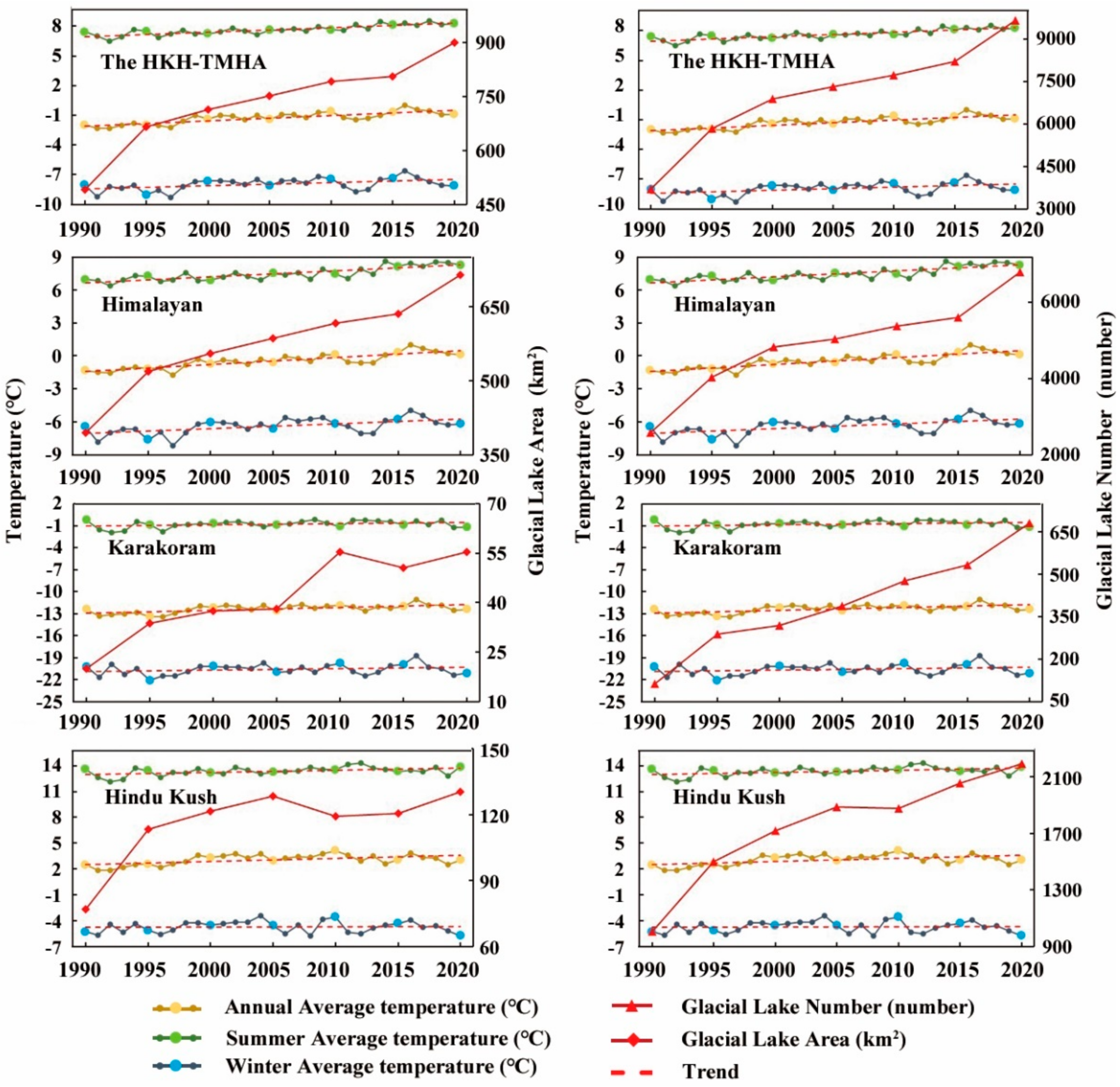
| Error | 1990 | 1995 | 2000 | 2005 | 2010 | 2015 | 2020 |
|---|---|---|---|---|---|---|---|
| Area Error (km2) | 1.30 | 1.44 | 1.51 | 1.56 | 1.67 | 1.72 | 1.78 |
| Relative Error (%) | 22.75 | 22.61 | 22.94 | 23.50 | 23.75 | 24.72 | 25.35 |
| Index | 1990–1995 | 1995–2000 | 2000–2005 | 2005–2010 | 2010–2015 | 2015–2020 |
|---|---|---|---|---|---|---|
| PAC | 35.48 | 7.32 | 5.33 | 5.28 | 1.90 | 11.60 |
| APAC | 6.26 | 1.42 | 1.04 | 1.03 | 0.38 | 2.22 |
| Region | 1990 | 1995 | 2000 | 2005 | 2010 | 2015 | 2020 |
|---|---|---|---|---|---|---|---|
| Eastern Himalayan | 1807 (248.81 ± 26.77) | 2420 (301.30 ± 32.60) | 2791 (336.61 ± 36.40) | 2998 (349.15 ± 38.80) | 3095 (371.73 ± 39.87) | 3115 (379.61 ± 40.10) | 3662 (423.37 ± 45.67) |
| Central Himalayan | 438 (53.70 ± 6.49) | 677 (70.13 ± 9.12) | 759 (75.88 ± 9.90) | 722 (75.56 ± 9.34) | 833 (80.24 ± 10.73) | 845 (85.01 ± 10.88) | 1149 (100.75 ± 14.33) |
| Western Himalayan | 328 (88.29 ± 4.86) | 940 (142.93 ± 12.66) | 1277 (138.35 ± 16.65) | 1314 (157.28 ± 17.0) | 1446 (161.31 ± 18.63) | 1644 (167.38 ± 21.17) | 1979 (186.50 ± 24.68) |
| Karakoram | 112 (19.87 ± 1.66) | 288 (33.67 ± 3.88) | 320 (37.41 ± 4.17) | 389 (38.05 ± 5.03) | 478 (55.39 ± 6.16) | 534 (50.58 ± 6.87) | 680 (55.41 ± 8.48) |
| Hindu Kush | 1007 (76.76 ± 14.92) | 1499 (113.14 ± 20.19) | 1721 (121.60 ± 22.44) | 1885 (128.43 ± 24.39) | 1875 (119.30 ± 24.16) | 2055 (120.58 ± 26.46) | 2192 (130.47 ± 27.34) |
| Region | 1990–1995 | 1995–2000 | 2000–2005 | 2005–2010 | 2010–2015 | 2015–2020 |
|---|---|---|---|---|---|---|
| Eastern Himalayan | 613/52.49 (33.92%/21.1%) | 371/35.31 (15.33%/11.72%) | 207/12.54 (7.42%/3.73%) | 97/22.58 (3.24%/6.47%) | 20/7.88 (0.65%/2.12%) | 547/43.76 (17.56%/11.53%) |
| Central Himalayan | 239/16.43 (54.57%/30.58%) | 82/5.76 (12.11%/8.21%) | −37/−0.32 (−4.87%/−0.42%) | 111/4.68 (15.37%/6.19%) | 12/4.77 (1.44%/5.94%) | 304/15.74 (35.98%/18.52%) |
| Western Himalayan | 612/54.64 (186.59%/61.88%) | 337/−4.58 (35.85%/−3.21%) | 37/18.93 (2.9%/13.68%) | 132/4.04 (10.05%/2.57%) | 198/6.07 (13.69%/3.7%) | 335/19.12 (20.38%/11.42%) |
| Karakoram | 176/13.80 (157.14%/69.46%) | 32/3.74 (11.11%/11.11%) | 69/0.64 (21.56%/1.72%) | 89/17.34 (22.88%/45.58%) | 56/−4.81 (11.72%/−8.68%) | 146/4.82 (27.34%/9.54%) |
| Hindu Kush | 492/36.38 (48.86%/47.4%) | 222/8.46 (14.81%/7.48%) | 164/6.82 (9.53%/5.61%) | −10/−9.13 (−0.53%/−7.11%) | 180/1.29 (9.6%/1.08%) | 137/9.89 (6.67%/8.2%) |
| Study Region | Coverage | Study Period | Glacial Lake Area/Number | Reference |
|---|---|---|---|---|
| HMA | 26–45° N, 67–105° E | 2008–2017 | 1635.94 km2 | Chen, et al. [44] |
| HMA | 26–54° N, 67–104° E | 1990–2018 | 2080.12 ± 2.28 km2 | Wang, et al. [46] |
| HMA | 26–42° N, 71–103° E | 2008–2016 | 1577.38 ± 288.82 km2 | Zhang, et al. [42] |
| Third Pole | 25–40° N, 67–104° E | 1990–2010 | 682.4 ± 110 km2 | Zhang and Yao, et al. [43] |
| HKH | 25–38° N, 67–98° E | 2005 (±2 years) | 1444 km2 | Maharjan, et al. [45] |
| Chandra Basin | 32°05′–32°45′ N, 76°50′–77°50′ E | 2000–2014 | 3.26 ± 0.24 km2 | Prakash and Nagarajan [87] |
| Cordillera Vilcanota | 0°–20° S, 65°–80° W | 1975–2012 | 50 (number) | Hanshaw and Bookhagen [88] |
| Alps | 44°–48° N, 6°–14° E | 2000–2019 | 33.77 ± 6.94 km2 | Ma, et al. [89] |
Publisher’s Note: MDPI stays neutral with regard to jurisdictional claims in published maps and institutional affiliations. |
© 2022 by the authors. Licensee MDPI, Basel, Switzerland. This article is an open access article distributed under the terms and conditions of the Creative Commons Attribution (CC BY) license (https://creativecommons.org/licenses/by/4.0/).
Share and Cite
Li, W.; Wang, W.; Gao, X.; Wang, X.; Wang, R. Inventory and Spatiotemporal Patterns of Glacial Lakes in the HKH-TMHA Region from 1990 to 2020. Remote Sens. 2022, 14, 1351. https://doi.org/10.3390/rs14061351
Li W, Wang W, Gao X, Wang X, Wang R. Inventory and Spatiotemporal Patterns of Glacial Lakes in the HKH-TMHA Region from 1990 to 2020. Remote Sensing. 2022; 14(6):1351. https://doi.org/10.3390/rs14061351
Chicago/Turabian StyleLi, Wenping, Wei Wang, Xing Gao, Xuecheng Wang, and Ruohan Wang. 2022. "Inventory and Spatiotemporal Patterns of Glacial Lakes in the HKH-TMHA Region from 1990 to 2020" Remote Sensing 14, no. 6: 1351. https://doi.org/10.3390/rs14061351






